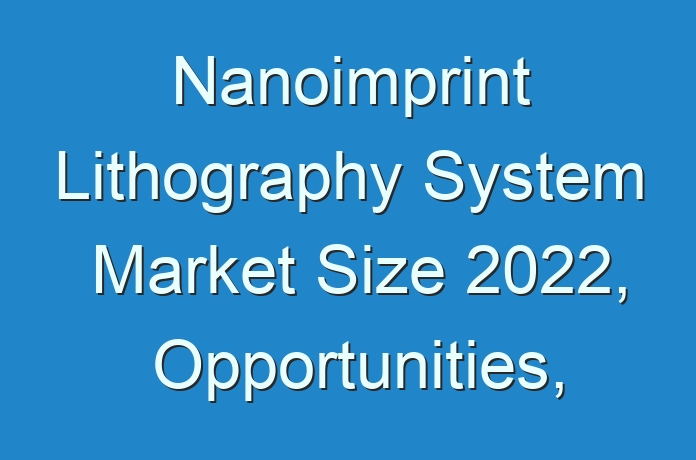
Nanoimprint lithography is a technique of fabricating nanometer scale patterns. It is a simple nanolithography process that provides high throughput, high precision, high resolution and low cost operation. Nanoimprint lithography systems allows replication of patterns in the micro and nanometer range for Research & Development purposes. Currently this system is widely used across the globe for commercial semiconductor production. Nanoimprint lithography system work on a principle that is nanostructured polymer or silicon hybrid mold is pressed with controlled temperature and pressure on a substrate coated with a defined layer of polymeric material. An inverse reproduction of the characteristic would be imprinted on the substrate after removal of the mold. Nanoimprint technology does not require shorter wavelength light sources, multiple patterning, and expensive optics, as it uses the simple method of physically applying a mask into which the circuit pattern have been cut to reduce the cost significantly, and to minimize the chip failure rates.
Market Dynamics: Global Nanoimprint Lithography System Market
The major driving factor for growth of the global nanoimprint lithography system market is due to increasing use of nanoimprint lithography technology in various applications such as consumer electronics, optical equipment, medical devices, and others. In solar cell, to obtain a desired texture, UV nanoimprint lithography (UV-NIL) is used as a substitute for traditional lithography to reduce process complexity, and to have benefits of a defined texture in industrially feasible processes. Hence, UV-NIL system is used to offer new possibilities in terms of resolution of the generated etching mask and shape of its structure. Moreover, nanoimprint lithography has been proposed for hard disk drives to squeeze more bits onto each platter of an HDD. Also, in order to improve memory efficiency and performance, smartphone manufacturers are planning to use NIL technology as nanoimprinting is capable of replacing features below 10 nm. As a result of these factors, use of nanoimprint lithography technology in consumer electronic applications is expected to fuel growth for the nanoimprint lithography system market during the forecast period. Moreover, nanoimprint lithography system is ideally suited for the manufacturing of optical features, such as optical grating or miniaturized lenses as it has the ability to replicate complex three dimensional shapes accurately in a single process step. This technology also helps in the formation of textured surfaces such as nano scale patterned surfaces and microfluidic channels for bio-medical applications. Considering these factors, nanoimprint lithography system market is anticipated to show prominent growth in coming years. Furthermore, as nanoimprint lithography is a new technique and provides ability to form nano scale patterns at low cost as compared to conventional lithography methods, it is expected to offer significant growth opportunity to the nanoimprint lithography system market.
Planning to lay down future strategy? Perfect your plan with our report sample here https://www.transparencymarketresearch.com/sample/sample.php?flag=S&rep_id=61026
Market Segmentation: Global Nanoimprint Lithography System Market
The global nanoimprint lithography system market has been segmented based on product type, application, and region. Based on product type, the global nanoimprint lithography system market can be classified into hot embossing system, UV based nanoimprint lithography system, micro contact printing system, and others. Based on application, the nanoimprint lithography system market can be segmented into consumer electronics, optical equipment, medical devices, and others. Additionally, based on geography the nanoimprint lithography system market is further segregated into North America, Europe, Asia Pacific, Middle East & Africa, and South America.
Key Players:
Some of the key players operating in the global nanoimprint lithography system market with significant developments include Canon Inc., obducat, EV Group, Nanonex Corporation, micro resist technology GmbH, and SÜSS MICROTEC SE among others. These players are actively focusing on organic and inorganic growth strategies in order to gain a competitive advantage in the nanoimprint lithography system market. Some of the important strategies adopted by the leading players in the global nanoimprint lithography system market are collaborations, partnerships, agreements, and new product launches. The report provides an in-depth analysis about the strategic business activities along with the market dynamics shaping the global nanoimprint lithography system market over the period of study.
The report offers a comprehensive evaluation of the market. It does so via in-depth qualitative insights, historical data, and verifiable projections about market size. The projections featured in the report have been derived using proven research methodologies and assumptions. By doing so, the research report serves as a repository of analysis and information for every facet of the market, including but not limited to: Regional markets, technology, types, and applications.
The study is a source of reliable data on:
- Market segments and sub-segments
- Market trends and dynamics
- Supply and demand
- Market size
- Current trends/opportunities/challenges
- Competitive landscape
- Technological breakthroughs
- Value chain and stakeholder analysis
The regional analysis covers:
- North America (U.S. and Canada)
- Latin America (Mexico, Brazil, Peru, Chile, and others)
- Western Europe (Germany, U.K., France, Spain, Italy, Nordic countries, Belgium, Netherlands, and Luxembourg)
- Eastern Europe (Poland and Russia)
- Asia Pacific (China, India, Japan, ASEAN, Australia, and New Zealand)
- Middle East and Africa (GCC, Southern Africa, and North Africa)
Looking for exclusive market insights from business experts? Buy Now Report here https://www.transparencymarketresearch.com/checkout.php?rep_id=61026
The report has been compiled through extensive primary research (through interviews, surveys, and observations of seasoned analysts) and secondary research (which entails reputable paid sources, trade journals, and industry body databases). The report also features a complete qualitative and quantitative assessment by analyzing data gathered from industry analysts and market participants across key points in the industry’s value chain.
A separate analysis of prevailing trends in the parent market, macro- and micro-economic indicators, and regulations and mandates is included under the purview of the study. By doing so, the report projects the attractiveness of each major segment over the forecast period.





